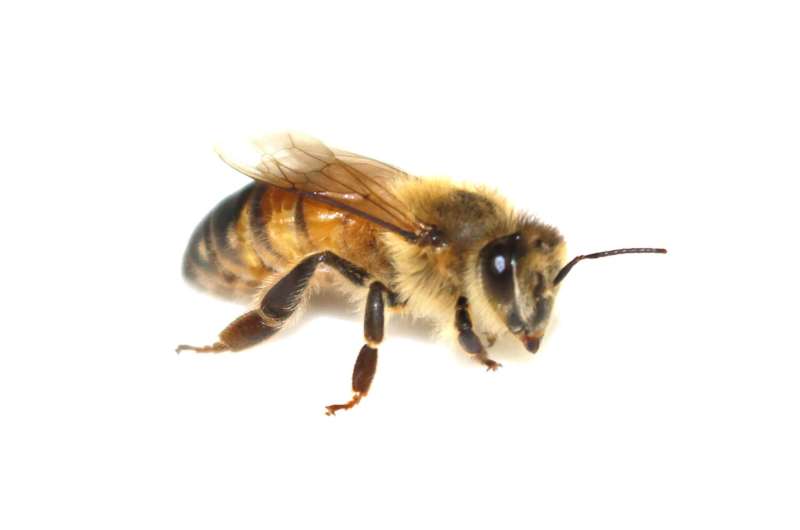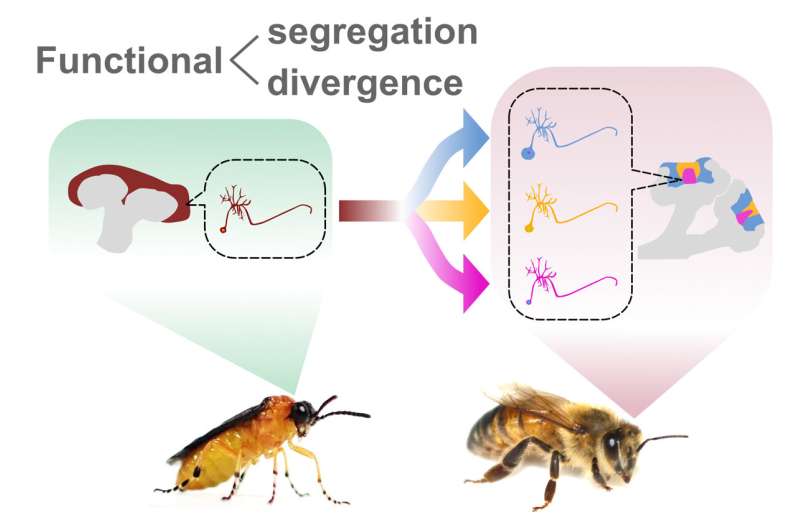This article has been reviewed according to Science X's editorial process and policies. Editors have highlighted the following attributes while ensuring the content's credibility:
fact-checked
peer-reviewed publication
trusted source
proofread
A new model for the evolution of honey bee brains

Researchers have proposed a new model for the evolution of higher brain functions and behaviors in the Hymenoptera order of insects. The team compared the Kenyon cells, a type of neuronal cell, in the mushroom bodies (a part of the insect brain involved in learning, memory and sensory integration) of "primitive" sawflies and sophisticated honey bees.
They found that three diverse, specialized Kenyon cell subtypes in honey bee brains appear to have evolved from a single, multifunctional Kenyon cell-subtype ancestor. In the future, this research could help us better understand the evolution of some of our own higher brain functions and behaviors.
Are you "busy as a bee," a "social butterfly" or a "fly on the wall?" There are many ways we compare our behavior to that of insects, and as it turns out there may be more to it than just fun idioms. Studying insects could help us understand not only how their behavior has evolved, but also the behavior of highly evolved animals, including ourselves.
Mammalian brains are big and complex, so it is difficult to identify which behaviors and neural and genetic changes have co-developed over time. By comparison, insect brains are much smaller and simpler, making them useful models for study.
"In 2017, we reported that the complexity of Kenyon cell (KC) subtypes in mushroom bodies in insect brains increases with the behavioral diversification in Hymenoptera (a large and varied order of insects)" explained Professor Takeo Kubo from the Graduate School of Science at the University of Tokyo and co-author of the current study published in Science Advances.
"In other words, the more KC subtypes an insect has, the more complex its brain and the behaviors it may exhibit. But we didn't know how these different subtypes evolved. That was the stimulus for this new study."
The team from the University of Tokyo and Japan's National Agriculture and Food Research Organization (NARO) chose two Hymenoptera species as representatives for different behaviors: the solitary turnip sawfly (which has a single KC subtype) and the sophisticated, social honey bee (which has three KC subtypes).
As the sawfly has a more "primitive" brain, it is thought to contain some ancestral properties of the honey bee brain. To uncover the potential evolutionary pathways between them, the researchers used transcriptome analysis to identify the gene expression profiles (the genetic activity) of the various KC subtypes and speculate their functions.

"I was surprised that each of the three KC subtypes in the honey bee showed comparable similarity to the single KC type in the sawfly," said Assistant Professor Hiroki Kohno, co-author from the Graduate School of Science. "Based on our initial comparative analysis of several genes, we had previously supposed that additional KC subtypes had been added one by one. However, they appear to have been separated from a multifunctional ancestral type, through functional segregation and specialization."
As the number of KC subtypes increased, each subtype almost equally inherited some distinct properties from an ancestral KC. These then modified in different ways, resulting in their varied present-day functions.
The researchers wanted a specific behavioral example of how ancestral KC functions are present in both the sawfly and the honey bee. So, they trained sawflies to engage in a common honey bee behavior test, where they learn to associate an odor stimulus with a reward. Although challenging at first, the team was eventually able to engage the sawflies in the memory task.
The researchers then manipulated a gene called CaMKII in sawfly larvae, which in honey bees is associated with forming long-term memory, a KC function. When the larvae became adults, their long-term memory was impaired, indicating that the gene plays a similar role in both sawflies and honey bees. Although CaMKII was expressed (i.e., was active) across the entire single KC subtype in sawflies, in honey bees, it was preferentially expressed in only one KC subtype. This suggests that the role of CaMKII in long-term memory was passed down to the specific KC subtype in the honey bee.
Despite differences in the size and complexity of insect and mammalian brains, there are commonalities in terms of function and the basic architecture of the nervous system. That is why the model proposed in this study for the evolution and diversification of KC subtypes may help towards better understanding the evolution of our own behavior. Next, the team is interested in studying KC types acquired in parallel with social behaviors, such as the honey bee's "waggle dance."
"We would like to clarify whether the model presented here is applicable to the evolution of other behaviors," said Takayoshi Kuwabara, doctoral student and lead author from the Graduate School of Science. "There are many mysteries about the neural basis that controls social behavior, whether in insects, animals or humans. How it has evolved still remains largely unknown. I believe that this study is a pioneering work in this field."
More information: Takayoshi Kuwabara et al, Evolutionary dynamics of mushroom body Kenyon cell types in hymenopteran brains from multifunctional type to functionally specialized types, Science Advances (2023). DOI: 10.1126/sciadv.add4201. www.science.org/doi/10.1126/sciadv.add4201
Journal information: Science Advances
Provided by University of Tokyo

















